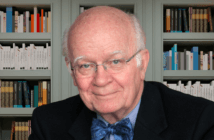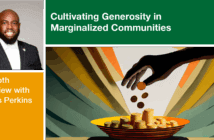
How can the church be more receptive and open as neighborhoods become more complex and culture more multi-faceted? In this episode we speak with consultant Paul Nixon who works to help churches meet the demands of a rapidly changing age.
Listen on Apple Podcasts | YouTube Music | Spotify
- Transcript
-
Announcer: Leading Ideas Talks is brought to you by the Lewis Center for Church Leadership of Wesley Theological Seminary in Washington, DC. Subscribe free to our weekly newsletter at churchleadership.com/leadingideas.
Leading Ideas Talks is also brought to you by Discovering God’s Future for Your Church. This turn-key video tool kit helps your congregation discern and implement God’s vision for your church’s next faithful steps. Discovering God’s Future for Your Church is available on download and DVD at churchleadership.com/shop.
How can leaders think outside of the box? In this episode we discuss innovation, entrepreneurial ministry, and leadership with Kenda Creasy Dean, the Mary D. Synnott Professor of Youth, Church, and Culture at Princeton Theological Seminary.
Ann Michel: I’m Ann Michel. I’m Associate Director of the Lewis Center for Church Leadership. And I’m the host of this Leading Ideas Talks Podcast. I’m pleased to be talking today with Paul Nixon who is the director of Church Multiplication for the United Methodist Church and he’s also the head of the Epicenter Group where he and his colleagues have coached or consulted with about 1,000 churches in North America and Europe. They work a lot with mergers, and new church starts, and multi-site initiatives. Paul is the author of several books, and his most recent book is “Multi: The Chemistry of Church Diversity.” So, I’m so glad to have you talking with us today, Paul.
Paul Nixon: I’m glad to be with you.
Ann: So, before we turn to the specifics of your book, I kind of wanted to put a broader frame around our conversation. Because I sense in this book, as well as some of your previous books, that because of your work with church planters and new church starts, and other leaders who are kind of at the green growing edges of the church, I think you really are a trend spotter. And I wanted to know what you’re seeing today that’s different than maybe a few years ago, or what are you really paying attention to as you survey the landscape of churches.
Paul: In terms of what was driving into this book, the thing that I was noting was the increasing complexity of neighborhood that surrounds churches. In the North American context — and certainly I work in the UK, it’s similar there – what we see is less homogeneity by zip code, by census block group. It used to be all the Italians lived over here, and the Irish over here, and the African American working class, and so forth. We were all sort of segregated. That really is mixing up more and more, especially with gentrification of cities, and so forth. What it means is that any church that has been around more than 40 years has seen massive changes in the neighborhood. They were once upon a time planted in a neighborhood they probably understood, and they designed ministry and message that made sense in that setting. That really has changed.
And so, we are sensing that there is a readiness on the part of many church leaders to really navigate a more “multi” approach to the way they do church. I think that’s one of the shifts that’s happening. MLK Jr. said about 50 years ago, he said, “11:00 is still the most segregated hour of the week.” Well, it probably still is. And we can talk about that in a moment. But that is definitely changing. And that is going to change, I believe radically, in the next quarter century.
Ann: So, you do think that the churches will become more diverse than they are now?
Paul: Oh, there is no doubt. And I think it has something to do with the capacity of people and the other life experiences they bring. People, especially the younger they get, the more so — but people, whether they have been in the military, or they have worked in industry, or just public schools, have lived in a more multi world than their grandparents. And that is equipping them. And they are marrying across all these cultural lines, as well. That is equipping them not only to be ready to do multi in the church life, but really to want it.
Ann: I was intrigued that in your book, you talked a lot about the multisite revolution of the past twenty-five year and that maybe that was giving way to some different patterns now. Where do you see that headed?
Paul: The multisite revolution is an interesting thing. That’s what got me on this project. And then, the more I looked at, the more I realized that the bigger revolution was not multisite, but the whole multi thing. But in terms of multisite, I was a pastor in one of the early multisite churches late in the 20th Century. And we thought at that time that this was a way for large congregations that were overflowing their space to find space to keep moving without having to either relocate or go into a gigantic capital campaign. And that is still true. But more and more of what we see with multisite is not the large church that is overflowing to another large space. But it’s the midsize church. It’s the dinner church that is having dinner in two locations and has a group that live over in another part of town. Or the church that has adopted a struggling congregation and now they are functioning as one congregation in two sites. But neither of them would have been the kind of church we would have thought about doing multisite twenty years ago.
Ann: So, it’s not a facility usage question. It’s more of a strategy for connecting and outreach.
Paul: Yes, very much so.
Ann: So, when I picked up the book “Multi,” my thought on reading the title was that it was going to be another book on multicultural and multiethnic ministry. And I think what really surprised me about it is it’s so much more. You’re talking about a church’s capacity to embrace difference and change in any number of different ways, whether it’s different generations, different theological perspectives, across different locations. So, can you define what a “multi church” is, in your way of thinking?
Paul: It really is a church that is taking different cultures and helping to bond them together. And I think “culture” is the right word, although I don’t really use the word that much in the book. As I’ve reflected on the book, I think the word “culture” is a word I might have used more. You can have generational culture. People speak the same language. They grew up in the same community, but the culture of the teenagers is significantly different than the culture of the grandparents. So, you can have generational culture, you can have culture that revolves around language, around nations of origin, and so forth and so on. I think the way we are using “multi” is different culture. Of course, what we see in the United States right now is political cultures and world view are very, very different. And it may not involve language. It may not involve significant ethnicity in terms of difference. But the cultural challenges are quite significant.
Ann: Right. So, you address transcending different theological world views, different liturgical traditions, different linguistic traditions, different generations. And I think, if I’m reading it right, that the thesis of your books is that across any of one of these dimensions of diversity that a congregation may wish to engage, there are some sort of basic capacities and characteristics that allow a congregation to be in a position to be able to transcend some of those differences. Can you identify what some of those capacities and characteristics are that make a congregation more capable of opening itself to these different kinds of differences?
Paul: Well, I think it is a capacity for listening. Listening to a person’s story is the most basic capacity. It’s not hard to learn. But we do have to slow ourselves down and sometimes we have to check our defensive/reflexive thoughts that are going through our mind and realize that for the sake of this person, this child of God that I am talking to, strange as they may be to my experience, I want to turn all of that stuff off in my brain, and I really just want to hear “where they are coming from?” And I think that is the most basic capacity is to pay attention to that. I think there is the capacity to in a group setting to lean in toward the person who is having the hardest time articulating their story, or their thought or their point of view. And often when you are doing group work, and we do that at church –especially around leader teams, worship planning teams, ministry design teams — there are certain people that because of their live experience, they may be as I am, white, male, and relatively well-educated. And our mouths open easily to share our thoughts. And we can take up airtime. And we may need to recognize as a team that there may be others that we need to stop and really need to be still and to listen and be sure that their perspectives are being heard and being honored, as well. I do believe that the group life of a leader team becomes the laboratory where we work out how you do multi on a larger level. And if a team can work that out, and can move through some of the pinch points, and the discomfort, and the hurt feelings, and the awkwardness, they can lead a church to move through those same experiences on a larger scale.
Ann: I really took encouragement from your book in that you seem to be saying that any church can take a step in this direction and that you don’t need to tackle it all at once. You can decide on one these aspects of diversity that is the most important that you want to pursue and concentrate your effort there.
Paul: That is really a principle of the way I do consulting. And I think it’s also basic to what we believe theologically – that wherever you are, whatever your GPS is, wherever you find yourself both in terms of your institutional health or your capacities, it’s where you are. And God meets you there. And then there are faithful steps, there are good next steps from there. And I’ve tried to tell churches, especially churches that are struggling, or maybe kind of late in their lifecycle, or needing a major revisioning, it’s okay. We’re here. We’ve celebrated some wonderful past. Be we’re are here. And this is a good place. God is with us here. And there are faithful things you can do from here.
Ann: Do you think that there is always going to be niche for a congregation that caters to some specific demographic. Because I see that trend, too. The Divergent Church –these churches that are around specific affinities, or a lot of the things described in your book Weird Church – they are very niche experiments.
Paul: The answer would be yes, especially smaller, specialized congregations. Yes, there is going to be room for niche. I think the most obvious place that we’ve seen it over many years and will see in the future is with immigrant congregations, where you have a group of people that are coming from a very similar kind of experience and that is a niche. But even in the other niche congregations there is more complexity now that’s brought even into the niche congregations. People are listening to many more podcasts. And they are on different TV channels and different stations. So, there is a lot of difference that’s coming into what before would have been a rather simple and homogeneous group of people.
Ann: Yeah, I think one of the important subtexts that runs throughout your book is the idea that as churches become more diverse along any number of different dimensions, it’s still important that the church have a unifying principle, that there is a coherent identity and core narrative that’s holding it together. And I’m thinking maybe in a niche congregation that is built around arts or nature, that interest becomes the core principle and then people can manifest all kind of different diversities as long as they are interested in that particular expression of faith.
Paul: Agreed. I worked with a project here in the District of Columbia several years ago with deaf children. Some of the parents were deaf, some were not. But the common interest was they wanted to give their children a faith community experience with other children and they wanted it to be a friendly place for deaf children. So, some of the sibling were deaf and some were not. But it was all around that. There were about forty people. That was the unifying theme. That was definitely niche. But if you got to know those folks, they were all over the spectrum in terms of religious background, ethnicity, theology. So, there was also considerable diversity in that niche group.
Ann: So for a more standard-issue congregation that was looking to become more multi and increase its diversity, that idea of having to have a core narrative, a coherent identity to hold it together, what would be some of the ways that a congregation could create that unity amidst diversity? I mean it probably wouldn’t be parents of deaf children. But I think maybe we’re not as aware of some of the common things that hold us together because we take it for granted in a homogeneous community.
Paul: Yes, we do. I think often it’s a passion around a particular mission or a particular demographic for which we really long to serve and to be connected and to be in community with that demographic, which could be a demographic that’s suffering or a demographic that’s just simply disconnected from faith community. It could revolve around that. It could revolve around the way we worship and gather in a distinctive way that’s maybe a little different than some of our neighbors. It is going to have something to do with distinctives. And I tend to say these arise organically out of the life of the church. And often, if we come together, we can name them and note them. Many churches that seem to be floundering, if you were to get significant folk together in a fellowship hall in a circle on a Saturday afternoon would begin to be able to name some of the things that make them distinctive, which could range from talents that are disproportionality contained in a congregation, professional kinds of experience. I worked with a church that was just full of retired schoolteachers, many, many years ago. We had a capacity for doing community children’s ministry that just came from the latent experience.
And those women did not want to teach Sunday School on Sunday morning. But there was a gift there having all those retired educators. And they had a blast and we were able to do something quite significant.
Ann: So, I think the more deeply I got into your book, the more I realized that at some level it was really about change, about the church needing to change, and the direction in which the church needed to change. I think the part that I found most provocative was the quote you had from Diana Butler Bass where she said that “the church of the future was going to be on the internet.”
Paul: Yeah, I about drove off the road when she said that on NPR that morning. And I thought that is just — It was one of those things … I mean, she may not even remember saying it, it was just one of those things you say. And yet, the way it hit me was there is so much more truth to that. Because the way in which we interact — twenty years ago we would not be able to imagine the way that we interact virtually and through the internet. We just couldn’t imagine it. And to press that with technology plus our increasing comfort with experiencing community, doing education and small group work that way. Twenty years hence, it’s just obvious to me that the church is going to be on the internet.
Ann: Yeah, I mean I thought the points you made about how that’s how people do so much of their work these days. If you are a student, that’s how you do so much of your study. if you are a younger adult, that is how you are meeting people. That’s probably how you are going to get connected with the person you marry. If you can do all the important life work and relational work on the internet, why wouldn’t that be the place where the faith community would live. I found that incredibly, incredibly provocative. It made me think that the church that my grandchildren might go to is going to be entirely different from what my experience of church is.
Paul: It will be different. That church of our grandchildren is going to be different. And yet, if we could just zoom out fifty years and see it, we would also recognize the tell-tale traits of church in ways that would probably delight us.
Ann: There’s been so much more attention to churches with online worship, and being hospitable to their online visitors, and being beginning to be more cognizant of the need to provide people the opportunity to give online, but that’s all still built around our same basic framework. And you’re talking about, you know, not just taking what we do and put it online, but that church will be designed in a totally different way to live in an online space.
Paul: We will see a lot of resources coming out helping us to get our minds and practice around that, I’m sure, in the next twenty years. I do believe that in the American context we are so nimble about starting a ministry for anybody and everybody. And it’s one of the reasons we’ve stayed relatively healthy in terms of church life in this country when many other Western countries have really struggled and seen major decline. We are seeing our challenges now, but we stayed ahead of the wave for at least half a century. And I think that’s because we were innovating to create a church for anybody and everybody and often in a very niche sort of way.
The shift from church being the most homogeneous unit of American community, to the point that it can be hijacked by politicians —- we are probably seeing the end of that era. I do believe that churches are going to be intentionally much more diverse in the future and that will include political diversity. I’m almost certain of that. And with that political diversity, I think it becomes harder for us to be harnessed by a candidate or by a particular political movement. In a diverse church it’s harder to pull that off.
Ann: That’s interesting to me. Because I’ve heard other observers of church life say that in small communities, in rural communities, where there’s maybe one Lutheran Church, or one United Methodist Church, people don’t have any choice but to come together across their political differences. And so, within one congregation you may have Red and Blue. But that once you get into an urban context, people can self-select more easily.
Paul: They can. And in this era, we do. But there are all kinds of reasons why we self-select. I think right now we are in an extremely polarized moment politically. That may pass. But we also choose to come together for powerful worship, we choose to come together to expose our children to people with other kinds of stories. There are a lot of different motivations that pull people into a church or make a church a very special and magical kind of experience for them. And I think we are going to see more mixing.
If there was anybody that I would be paying attention to right now, with regard to kind of where it’s all going, I would be paying attention to young seminary graduates, under the age of say 35, and especially Evangelicals, and look at how different they are than the 55-year-olds and 65-year-olds in terms of how they lead. Their instincts are very, very different. And I think are more embracing of diversity, certainly. So thankfully, there is always a new generation coming after us to clean up the mess that we make.
Ann: I do think that one of the really positive messages of your book is that churches don’t have to go from zero to sixty on this. They can begin to work on perhaps one aspect of the multivalence that you describe. So, if a church wanted to head down that road, what would be the steps that you would recommend that they take. How would they decide which dimension of diversity was important for them to tackled and then how would they walk down that road?
Paul: It begins in a prayerful walk around the neighborhood. I mean literally, but not just literally. There has to be a contemplative space where we just get out of decision making and strategizing and we just look around. And we have some conversation. And we begin to assess what are some of our gifts and capacities and assets that we have to offer, both in terms of people and facilities, whatever. And looking at our neighborhood, what are some of the possibilities for collaboration? What seems to be an easy beginning?
Ann: So, it’s contextual.
Paul: it’s very contextual. And I say start small.
Ann: I think a lot of pastors are very cognizant of the need to be doing the kind of thing that you’re talking about. But a lot of the people in the pews – it may not be how they see reality. So how does a pastor or another leader in the congregation start to build some energy and awareness within a congregation around a need to go in a new direction like this?
Paul: Well, I’ve always begun with the idea that you don’t pull out the rug from underneath the people that are already there, but that you begin with an honoring of the good that is in the ministry that is there, and a respect for it. My mom is 82. And I think about her when I am working with congregations that have perhaps a shrinking population, that may be a little bit isolated from the neighbors. Her role as a lay person in her church — which went through a very compelling turnaround in inner-city Dallas — her role as a lay persons was to be a person who pointed to the positive when people were getting uncomfortable about the changes, and the new people, and all the shifting. And she continued over those decades to sit in the same row, she was always teaching her Bible class. And she was sort of a lay stabilizer. I think a few good layfolk in churches that have a good orientation to the fact that the church isn’t about us ultimately, but it’s about God and what God wants to do in the neighborhood, can really be helpful to those who lose their equilibrium over change. And often, we are talking about folks that are later in life, and everything seems to be changing, anyways. They are dealing with the death of a spouse. They are losing some independence. And now the church is bringing all these new people in. And it’s just more than they can take. And I think it takes great care to love people and to realize that most of these folks, in their best moment, and when they are not going through a sense of crisis themselves, would be for good change, and for reaching and loving neighbors.
Ann: I think you do have to keep framing that for people. In my church I know there are people whose attitude is “Well, the church meets my needs.” And when you come to them with the idea of something new, that’s the standard that they evaluate it by. And if that’s were a lot of people are in the church, I think it’s hard for them to think proactively about the possibility of church being something different.
Paul: I am reminded of a church in Oregon where we heard this kind of thing. And we said, “Well, at the rate we’re going we’ll be turning out the lights in 2029.” We just kind of ran the numbers and the trends. To which the response was, “So what!’
Ann: I’ll be dead by then!
Paul: I will have had a good run by then. This will have worked for me and for most of my friends. “So What!” And then we had to deal with the “So What.” And I think that’s an important thing to deal with. We say the “Me Generation” is a little younger, but I think all of us have a little bit of egocentric way that we go about life, especially when we are in a place of grieving all the changes to really make church a comfort zone and a therapeutic place of comfort and sort of getting ready for the next seven days for ourselves. Church is more than that. And when churches are in the height of their energy, and their world change, they are much more than that. And the funny thing is I think most people are able, when gently confronted with that challenge, to stop and to realize, “Yeah, the church is more than that.” And often the thought of the church being a blessing to the next generation, to people they don’t even know yet, is really a lovely thing. To think as you are approaching the end of your time on this planet, to think “I could have an investment through the renewal of this place in planting a tree that’s going to give shade to a lot of other people.”
Ann: But it may not be the renewal of this place.
Paul: It may not be the renewal of this place.
Ann: Because I think in what you are saying, and it’s a very hopeful message, but it may not be that every single local congregation continues in the same form that we know it. Most probably won’t.
Paul: Right. Most will not.
Ann: And yet understanding that doesn’t mean that God is through with the church. And understanding that we still have a responsibility to see the Christian message continue to a new generation, but it may be in very different ways. I think encouraging people to think a little bigger about what our task is is helpful as well. To bring this to a close. What are you focusing on next? Is this diversity issue still really the place?
Paul: Oh, this is the place. This is something that I will be working on for years. I think it’s a critical issue. It’s not like we are going to tackle this and ace it and be on to the next challenge. This is a big, big piece. I expect to be working on this for the next twenty years. I mean I really do think that helping churches navigate the shift to becoming intentionally more multivalent in their way of being is very important work in whatever sense it is.
Ann: Well, I thank you for that commitment to this work, Paul, because it’s certainly helped me put a bigger frame around this issue of diversity and see how critical it is as the church changes and addresses a more and more complex future. So, thanks so much for this work, thanks for the book, and thanks for talking with us today. And I wish you luck in this.
Paul. Thanks. It’s good to be here.
Announcer: On the next Leading Ideas Talks, we speak with Ronald Slaughter, pastor of St. James AME church, about being a bridge builder and maintaining important traditions while still innovating.
Announcer: Thank you for joining us and don’t forget to subscribe free to Leading Ideas at churchleadership.com/leadingideas.
Related Resources
- Discovering God’s Future for Your Church Video Tool Kit
- Multi: The Chemistry of Church Diversity (Pilgrim Press, 2019) by Paul Nixon
- How Much Should It Cost to Plant a New Church? by Paul Nixon




